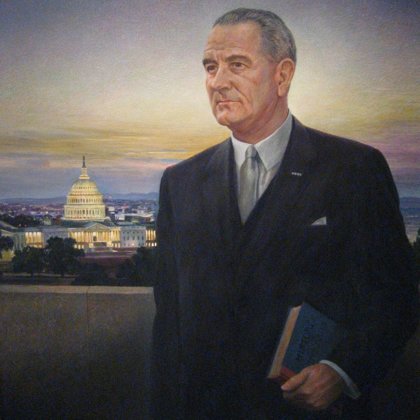LYNDON B.JOHNSON (1908 - 1973) SERVED AS THE 36TH PRESIDENT OF UNITED STATES.LYNDON JOHNSON TAKES OATH OF OFFICE ON BOARDS AIR FORCE ONE AFTER PRESIDENT KENNEDY ASSASSINATION IN 1963.JOHNSON WORKED TIRELESSLY TO PROMOTE CIVIL RIGHTS LEGISLATION .
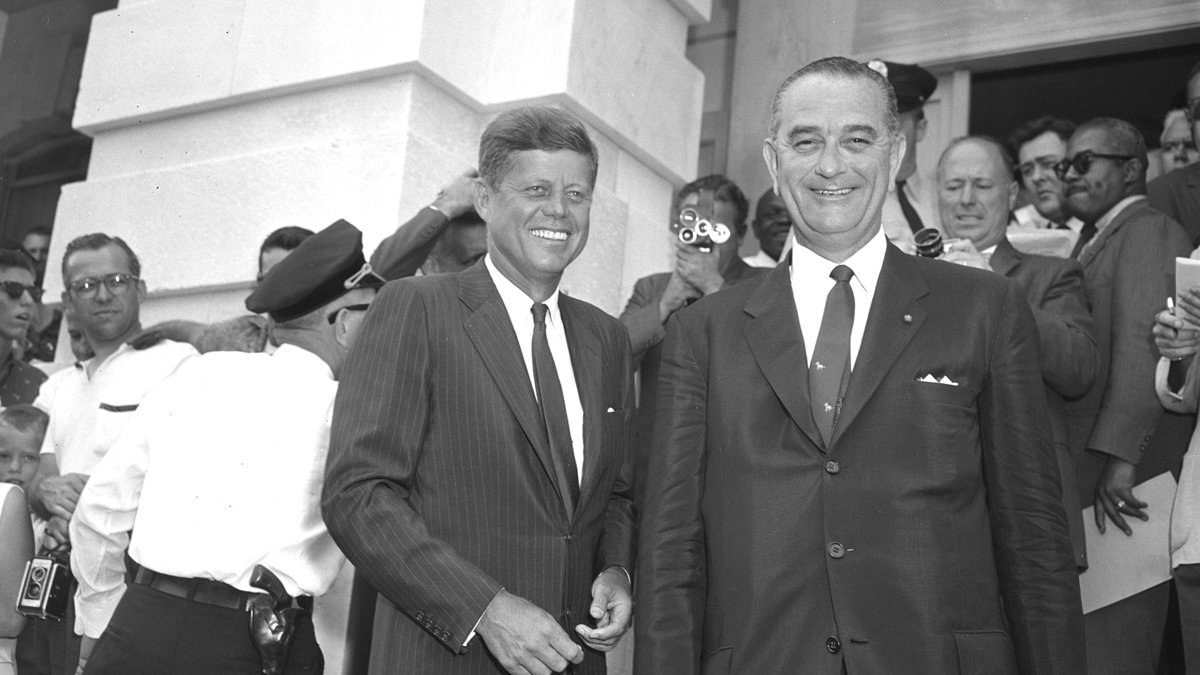 President
Lyndon B. Johnson is chiefly remembered for escalating the United
States military involvement in Vietnam. But his legacy is much more than
his role in the Vietnam War. In fact, Johnson engineered the passing of
two of the most important laws Congress ever approved: the Civil Rights
Act of 1964 and the Voting Rights Act on August
6, 1965, JFK & LBJ.Examines how Johnson meticulously worked behind
the scenes to outwit the Southern segregationists who were determined to
maintain the racial divide. He cajoled, flattered, wheeled and dealed,
using all the tricks he had learned as a long-serving Senator, to
ultimately transform America.
President
Lyndon B. Johnson is chiefly remembered for escalating the United
States military involvement in Vietnam. But his legacy is much more than
his role in the Vietnam War. In fact, Johnson engineered the passing of
two of the most important laws Congress ever approved: the Civil Rights
Act of 1964 and the Voting Rights Act on August
6, 1965, JFK & LBJ.Examines how Johnson meticulously worked behind
the scenes to outwit the Southern segregationists who were determined to
maintain the racial divide. He cajoled, flattered, wheeled and dealed,
using all the tricks he had learned as a long-serving Senator, to
ultimately transform America.
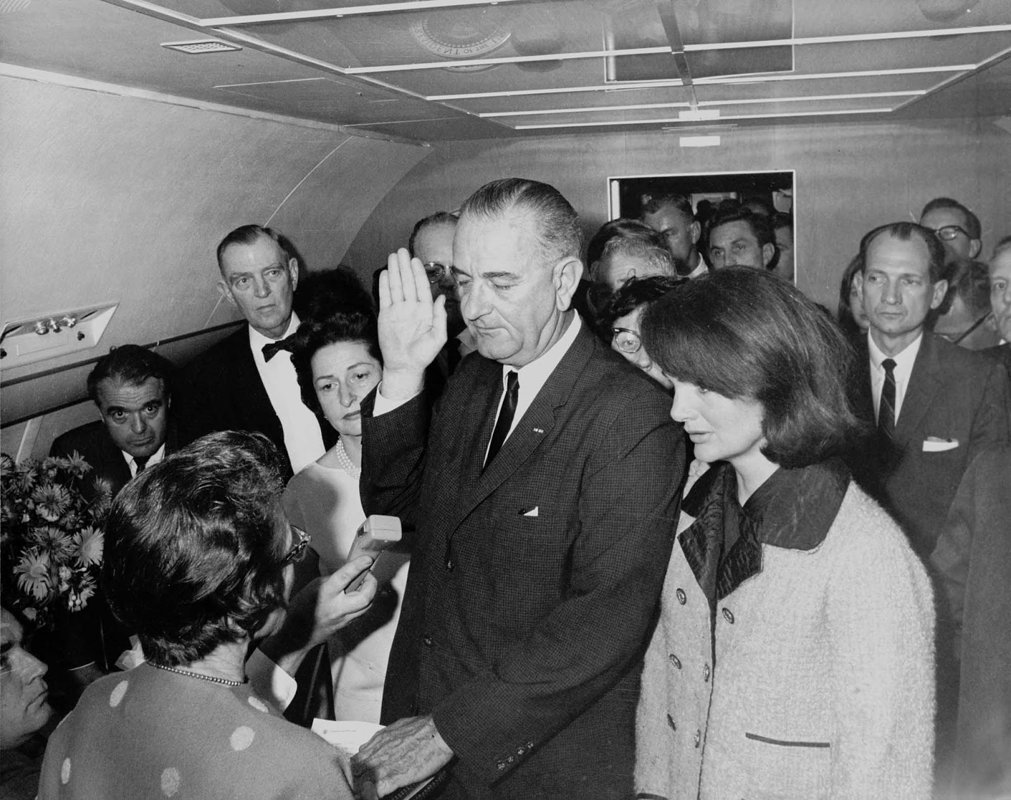 President
Johnson taking the Oath of Office on Air Force One, 1963.Flanked by
Jackie Kennedy and his wife, Ladybird, Vice President Lyndon Johnson is
sworn in as president of the United States of America by Dallas Federal
District Judge Sarah T. Hughes on November 22, 1963.President
Lyndon B. Johnson takes the oath of office aboard Air Force One at Love
Field in Dallas, Texas, following the assassination of President John
F. Kennedy. Jackie is angled in such a way as to hide the blood on her
coat. It’s the perfect image reflect the American Pain of the moment,
the quick need for seamless succession, and yet, and yet, in that
relatively desperate moment, attention is still given to the gloss and
optics of how the whole thing is presented.
President
Johnson taking the Oath of Office on Air Force One, 1963.Flanked by
Jackie Kennedy and his wife, Ladybird, Vice President Lyndon Johnson is
sworn in as president of the United States of America by Dallas Federal
District Judge Sarah T. Hughes on November 22, 1963.President
Lyndon B. Johnson takes the oath of office aboard Air Force One at Love
Field in Dallas, Texas, following the assassination of President John
F. Kennedy. Jackie is angled in such a way as to hide the blood on her
coat. It’s the perfect image reflect the American Pain of the moment,
the quick need for seamless succession, and yet, and yet, in that
relatively desperate moment, attention is still given to the gloss and
optics of how the whole thing is presented.Lyndon B. Johnson (LBJ) is one of the most interesting and controversial presidents of the United States.Born on 27th August 1908 in a small farmhouse near Stonewall, Texas, Lyndon Baines Johnson was the eldest of five children of Samuel Ealy Johnson Jr. and his wife Rebekah Baines. He had one brother, Sam Houston Johnson; and three sisters Rebekah, Josefa, and Lucia. The small town of Johnson City in Texas was founded by and named after James Polk Johnson, uncle of Lyndon and nephew of his grandfather Samuel Ealy Johnson, Sr. Lyndon’s father Samuel Johnson served as a Democratic member of the Texas House of Representatives for five terms. However, he lost money in cotton speculation leading to a financial crisis for the Johnson family. He struggled to raise his two sons and three daughters and thus Lyndon grew up under difficult circumstances. He was a confident and talkative boy who actively participated in public speaking, debate and baseball. Lyndon graduated from Johnson City High School in 1924 at the age of 15. He was president of his six-member senior class. Born in a family which was facing financial difficulty, Johnson struggled as a student before becoming a teacher for a brief period. He joined politics as a secretary to a Congressman and in 1937, at the age of 28, he was elected to the U.S. House of Representatives from Texas’s 10th district. He was elected to the Senate in 1948 and in 1953, he became the youngest Senate Minority Leader. Johnson became the Vice President of John F. Kennedy despite being involved in a bitter campaign against him for the Democratic ticket. Soon after Kennedy’s assassination on November 22, 1963, he was sworn in as the 36th President of the United States. Lyndon Johnson was known to be extremely hardworking and ambitious. He was a skillful politician famous for his intimidating technique of persuasion called The Treatment.Lyndon’s parents used their savings to send him to summer courses at Southwest Texas State Teachers College. However, he left the school just weeks after his arrival and instead moved to Southern California. Here, he did odd jobs and briefly worked in a cousin’s law office. Lyndon then returned to Texas and performed manual labor on a road crew. He became involved in drinking and fights; and was even arrested. In 1927, he refocused his energies on a teaching career and was accepted to Southwest Texas State Teachers College. Here, Johnson participated in debate and campus politics; and edited the school newspaper, The College Star. For 9 months in 1928–29, he paused his studies to teach Mexican-American children at the segregated Welhausen School in Cotulla. Later, after signing the Higher Education Act of 1965, President Johnson remembered the pain he felt while teaching these children realizing that “college was closed to practically every one of those children because they were too poor”. Johnson graduated from college in 1930 and worked as a teacher for four years. He then decided to pursue politics during the Great Depression.In 1934, Johnson met Claudia Alta Taylor, more known by her nickname “Lady Bird“. She was the daughter of a wealthy businessman named Thomas Jefferson Taylor. Johnson proposed to Claudia on their first date and the couple married on November 17, 1934, at St. Mark’s Episcopal Church in San Antonio, Texas. They had two daughters: Lynda Bird, born in 1944; and Luci Baines, born in 1947. Johnson, his wife and their two daughters all share the same initials, LBJ. He even named his dog Little Beagle Johnson. When Lyndon decided to run for Congress, Lady Bird provided the money to launch his campaign, taking $10,000 of her inheritance from her mother’s estate. During the 1964 presidential election, she traveled through eight Southern states in her own train to promote the Civil Rights Act. As First Lady, Lady Bird championed the Head Start education program as well as an environmental initiative aimed at the “beautification” of highways, neighborhoods and parks.During World War II, Lyndon B. Johnson was appointed a Lieutenant Commander in the U.S. Naval Reserve, in June, 1940. He worked on production and manpower problems that were slowing the production of ships and planes. He also participated as an observer on a number of bomber missions. On a tour of the southern Pacific, Johnson boarded a B-26 bomber called the Wabash Cannonball for his mission. Just before takeoff, he left the plane to use the washroom. On his return, he boarded another plane, the Heckling Hare. During the bombing mission, the Heckling Hare was forced to run back to base, while the Wabash Cannonball crashed into the sea, killing all on board. In 1942, Lyndon Johnson was awarded the Silver Star, the third-highest US combat medal for a fact-finding mission.Johnson nearly was killed in World War II. Johnson entered the Naval Reserves while still a Congressman, and on his only bombing run in the South Pacific, he boarded a plane called the Wabash Cannonball for his mission. A last-second trip off the plane to use a bathroom saved Johnson’s life. On his return from the facilities, Johnson boarded another plane that survived the mission. The Wabash Cannonball crashed, with a total loss of life.
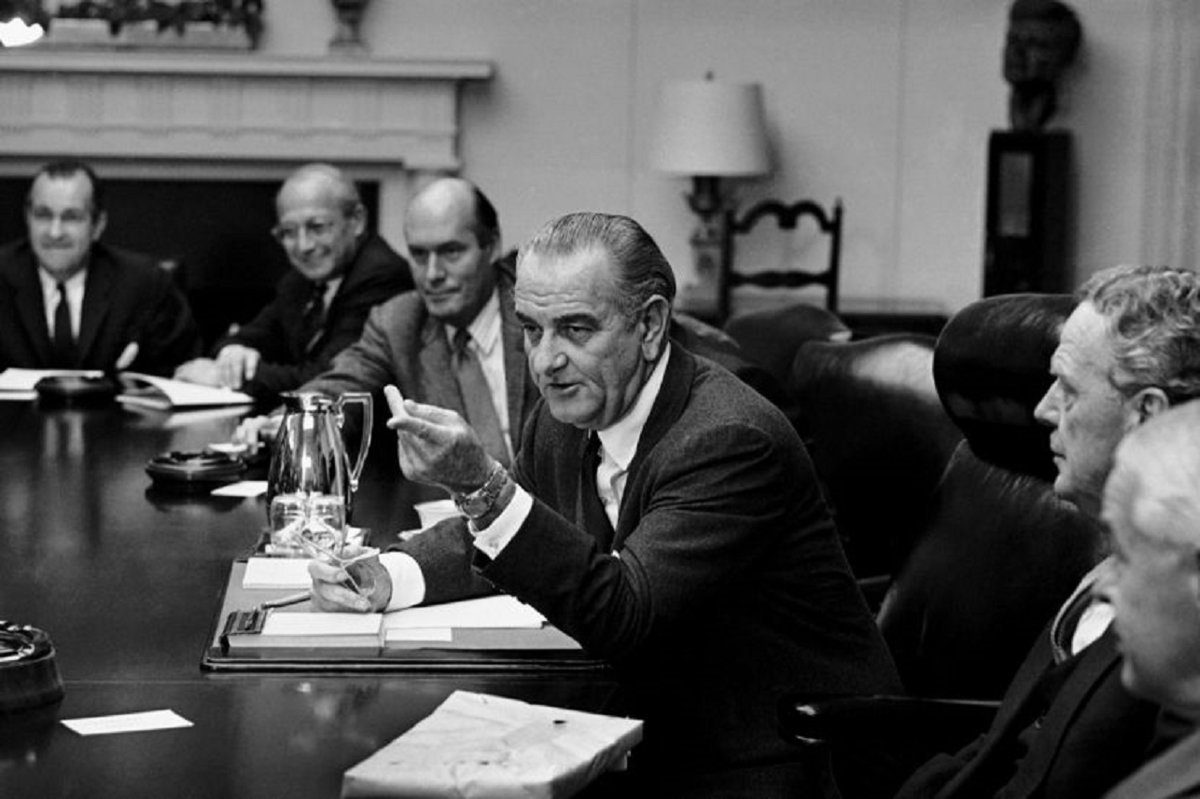 The
Civil Rights Act made it possible for Johnson to smash Jim Crow. The
Voting Rights Act made the U.S. government accountable to its black
citizens and a true democracy for the first time. Johnson lifted racist
immigration restrictions designed to preserve a white majority – and by
extension white supremacy. He forced FBI Director J. Edgar Hoover, then
more concerned with “communists” and civil rights activists, to turn his
attention to crushing the Ku Klux Klan. Though the Fair Housing Act
never fulfilled its promise to end residential segregation, it was
another part of a massive effort to live up to the ideals America’s
founders only halfheartedly believed in – a record surpassed only by
Abraham Lincoln.
The
Civil Rights Act made it possible for Johnson to smash Jim Crow. The
Voting Rights Act made the U.S. government accountable to its black
citizens and a true democracy for the first time. Johnson lifted racist
immigration restrictions designed to preserve a white majority – and by
extension white supremacy. He forced FBI Director J. Edgar Hoover, then
more concerned with “communists” and civil rights activists, to turn his
attention to crushing the Ku Klux Klan. Though the Fair Housing Act
never fulfilled its promise to end residential segregation, it was
another part of a massive effort to live up to the ideals America’s
founders only halfheartedly believed in – a record surpassed only by
Abraham Lincoln.
After becoming President, Johnson’s time in office came during a period of societal change in American society, marked by the Civil Rights revolution and the Vietnam War.Johnson’s legacy among historians and the public has also evolved since his death in 1973. Indeed, along with Richard Nixon, who followed him as President, Johnson is seen as a complex figure involved in many significant initiatives and events that have marked modern American history.So how did someone born into poverty in Texas and who started out as a school teacher become one of the pivotal figures of the 20th Century? By 1937, he won a special election to the U.S. House to replace a deceased House member named James Buchanan from Texas.Johnson was the “surrogate son” of powerful House Speaker Sam Rayburn. The legendary Rayburn had served in the Texas legislature with Johnson’s father, and Rayburn backed Johnson’s fast rise as a leader within Congress.Johnson nearly was killed in World War II. Johnson entered the Naval Reserves while still a Congressman, and on his only bombing run in the South Pacific, he boarded a plane called the Wabash Cannonball for his mission. A last-second trip off the plane to use a bathroom saved Johnson’s life. On his return from the facilities, Johnson boarded another plane that survived the mission. The Wabash Cannonball crashed, with a total loss of life.The Landslide Lyndon incident. Johnson won election to the U.S. Senate in 1948 after winning a Democratic primary by 87 votes. Allegations of voter fraud are still debated to this day about the election.Johnson quickly became the Senate’s leader. In 1953, he was named Senate minority leader after opposing Republicans gained control of the Senate. Two years later, Johnson became Majority Leader when Democrats regained power.The energetic Johnson reshaped the role of Senate Majority leader. Despite having a heart attack in 1955, Johnson worked tirelessly to promote himself, and agendas he backed, including Civil Rights legislation and the American space program. His ability to persuade politicians of both parties was legendary.Johnson lost a bitter campaign against Kennedy in the 1960 Democratic primary, and the Kennedys shocked observers by choosing Johnson as JFK’s running mate. One theory is that Johnson saw the position of Vice President as expanding his power base in the Senate. But after the 1960 election, Johnson was rebuffed when he tried to chair the Democratic conference in the Senate, and his fellow Democrats saw the move as a violation of the separation of powers between the executive and legislative branches. The Johnson presidency was incredibly active. In addition to pursuing the Vietnam War, President Johnson pressed on with an expansive slate of programs labeled as the Great Society that included three landmark Civil Rights bills and Medicare. But Vietnam’s impact damaged Johnson’s political base severely, and he declined to run in the 1968 presidential election.Education was not the only area toward which Johnson directed his attention. Consumer protection laws were also passed that improved the safety of meat and poultry, placed warning labels on cigarette packages, required “truth in lending” by creditors, and set safety standards for motor vehicles. Funds were provided to improve public transportation and to fund high-speed mass transit. To protect the environment, the Johnson administration created laws protecting air and water quality, regulating the disposal of solid waste, preserving wilderness areas, and protecting endangered species. All of these laws fit within Johnson’s plan to make the United States a better place to live. Perhaps influenced by Kennedy’s commitment to the arts, Johnson also signed legislation creating the National Endowment for the Arts and the National Endowment for the Humanities, which provided funding for artists and scholars. The Public Broadcasting Act of 1967 authorized the creation of the private, not-for-profit Corporation for Public Broadcasting, which helped launch the Public Broadcasting Service (PBS) and National Public Radio (NPR) in 1970.
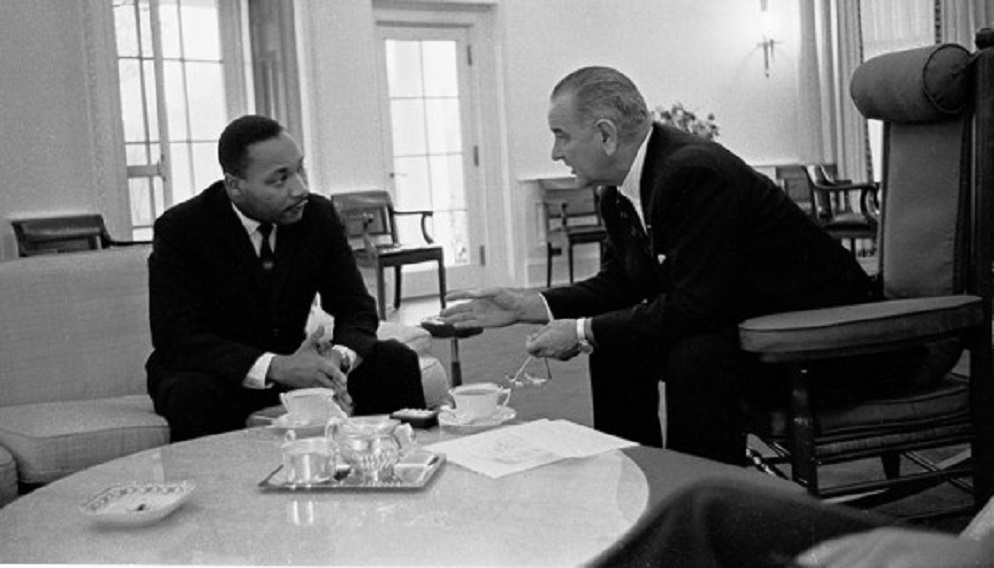 Dr.
Martin Luther King Jr. in Oval Office with President Lyndon B.
Johnson.As observances begin across the country, now is an appropriate
time to recall how fair housing was a key issue for Dr. Martin Luther
King, Jr. In fact, Chicago became his chosen battleground for fair
housing, bringing a national spotlight to the multiple ills of
segregated and sub-standard housing. In early 1966, Dr. King moved his
family into one of the city’s ghetto apartments to dramatize how people
were forced to live.
Dr.
Martin Luther King Jr. in Oval Office with President Lyndon B.
Johnson.As observances begin across the country, now is an appropriate
time to recall how fair housing was a key issue for Dr. Martin Luther
King, Jr. In fact, Chicago became his chosen battleground for fair
housing, bringing a national spotlight to the multiple ills of
segregated and sub-standard housing. In early 1966, Dr. King moved his
family into one of the city’s ghetto apartments to dramatize how people
were forced to live.
In 1965, the Johnson administration also encouraged Congress to pass the Immigration and Nationality Act, which essentially overturned legislation from the 1920s that had favored immigrants from western and northern Europe over those from eastern and southern Europe. The law lifted severe restrictions on immigration from Asia and gave preference to immigrants with family ties in the United States and immigrants with desirable skills. Although the measure seemed less significant than many of the other legislative victories of the Johnson administration at the time, it opened the door for a new era in immigration and made possible the formation of Asian and Latin American immigrant communities in the following decades.While these laws touched on important aspects of the Great Society, the centerpiece of Johnson’s plan was the eradication of poverty in the United States. The war on poverty, as he termed it, was fought on many fronts. The 1965 Housing and Urban Development Act offered grants to improve city housing and subsidized rents for the poor. The Model Cities program likewise provided money for urban development projects and the building of public housing.The Economic Opportunity Act (EOA) of 1964 established and funded a variety of programs to assist the poor in finding jobs. The Office of Economic Opportunity (OEO), first administered by President Kennedy’s brother-in-law Sargent Shriver, coordinated programs such as the Jobs Corps and the Neighborhood Youth Corps, which provided job training programs and work experience for the disadvantaged. Volunteers in Service to America recruited people to offer educational programs and other community services in poor areas, just as the Peace Corps did abroad. The Community Action Program, also under the OEO, funded local Community Action Agencies, organizations created and managed by residents of disadvantaged communities to improve their own lives and those of their neighbors. The Head Start program, intended to prepare low-income children for elementary school, was also under the OEO until it was transferred to Department of Health, Education, and Welfare in 1969.In 1948, Johnson ran for U.S. Senate. He was up against the popular Texas governor Coke Stevenson and George Peddy in the Democratic primary. In a highly controversial result with voter fraud allegations on both sides, Johnson was finally announced the winner by 87 votes out of 988,295 votes which were cast. The Democratic State Central Committee voted to certify Johnson’s nomination by a majority of one, 29 to 28. His critics gave him the derisive nickname “Landslide Lyndon” due to this controversial victory. In 1953, Johnson was chosen by fellow Democrats to be the Senate Minority Leader. Aged 44, he was the most junior Senator ever elected to this position. As the Democratic Party won the 1954 U.S. Senate elections, Johnson then became the Senate Majority Leader. He served in this position from 1955 to 1961.On recommendation of his father, Johnson was appointed legislative secretary to Congressman Richard M. Kleberg in 1931. He worked in this position till 1935, when he was appointed head of the Texas National Youth Administration. In this role, he helpedcreate educational and job opportunities for young people. In 1937, at the age of just 28, Johnson was elected to the U.S. House of Representatives from Texas’s 10th district. He won federal housing projects and dams for his district bringing electrical power to the lonely Texas Hill Country of his youth. He termed this as his proudest achievement in his life. The influential Democratic Congressman Sam Rayburn had served in the Texas legislature with Johnson’s father. He became a close friend and mentor of Lyndon; and aided Johnson’s rapid rise within Congress.Lyndon B. Johnson has been called the most effective Senate Majority Leader in history. He was unusually proficient at gathering information and he knew exactly where every Senator stood on issues, his philosophy and prejudices, his strengths and weaknesses and what it took to get his vote. He is famous for his tactics called The Treatment. The Johnson Treatment could last anywhere from ten minutes to four hours. It came whenever and wherever he found a fellow politician within his radius. He had all the research on his target in his pocket. “Its tone could be and included supplication, accusation, cajolery, exuberance, scorn, tears, complaint and the hint of threat.” Interjections from the target were rare and even if they were attempted, Johnson would anticipate them before they could be successfully delivered. All the elements LBJ used, “mimicry, humor, and the genius of analogy” rendered the target stunned, helpless, and obedient. It was this intimidating technique of persuasion that made Johnson one of the most feared and influential politicians of the time; and helped him get legislation passed like no other politician could. In the Democratic race to the 1960 U.S. presidential election, Lyndon B. Johnson was defeated by John F. Kennedy. Kennedy still offered Johnson the vice-presidential nomination.Johnson lost a bitter campaign against Kennedy in the 1960 Democratic primary, and the Kennedys shocked observers by choosing Johnson as JFK’s running mate. One theory is that Johnson saw the position of Vice President as expanding his power base in the Senate. But after the 1960 election, Johnson was rebuffed when he tried to chair the Democratic conference in the Senate, and his fellow Democrats saw the move as a violation of the separation of powers between the executive and legislative branches. This was despite the fact that John’s brother Robert F. Kennedy hated Johnson for his personal attacks on the Kennedy family during the bitter Democratic campaign. John Kennedy won the election making Johnson the 37th Vice President. Johnson’s influence as Vice President was limited as Kennedy’s advisers, especially his brother, made sure to keep him on the sidelines. On November, 22, 1963, President Kennedy was assassinated in Dallas, Texas, while traveling in a motorcade. Johnson was only two cars behind Kennedy when the shots rang out. Just 2 hours and 8 minutes later, Lyndon B. Johnson was sworn in as the 36th President of the United States. He then won the 1964 presidential election by defeating the Republican nominee Barry Goldwater by a landslide. Johnson served as President till January 20, 1969. He didn’t run for re-election even though he was constitutionally permitted to do so as he had served for less than 24 months of President Kennedy’s term.The energetic Johnson reshaped the role of Senate Majority leader. Despite having a heart attack in 1955, Johnson worked tirelessly to promote himself, and agendas he backed, including Civil Rights legislation and the American space program. His ability to persuade politicians of both parties was legendary.
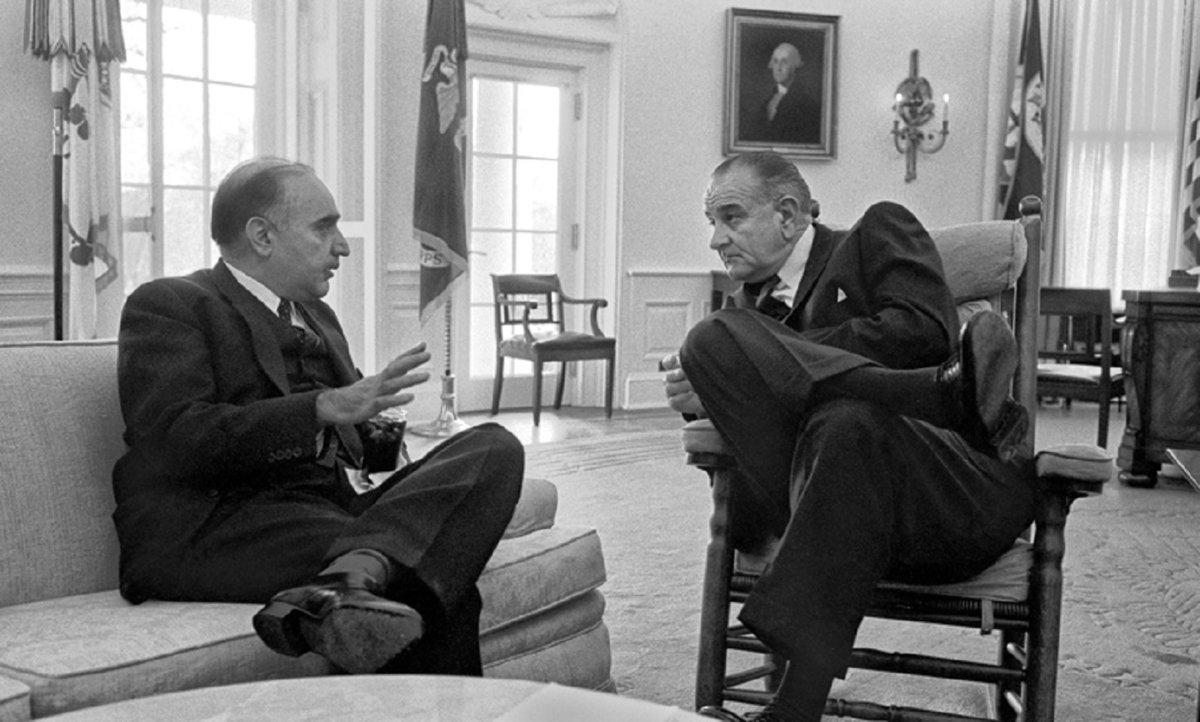 The
President presented the Prime Minister with an engraved silver desk set
and a series of leather-bound volumes of American history and
literature. Maiwandwal also met with officials at USAID and the Peace
Corps, and President Johnson pledged additional support for the
continued development of Afghanistan’s infrastructure. The Prime
Minister’s tour of the United States included a stop in Santa Barbara
where he received an honorary Doctor of Laws degree from the University of California.
The
President presented the Prime Minister with an engraved silver desk set
and a series of leather-bound volumes of American history and
literature. Maiwandwal also met with officials at USAID and the Peace
Corps, and President Johnson pledged additional support for the
continued development of Afghanistan’s infrastructure. The Prime
Minister’s tour of the United States included a stop in Santa Barbara
where he received an honorary Doctor of Laws degree from the University of California.
